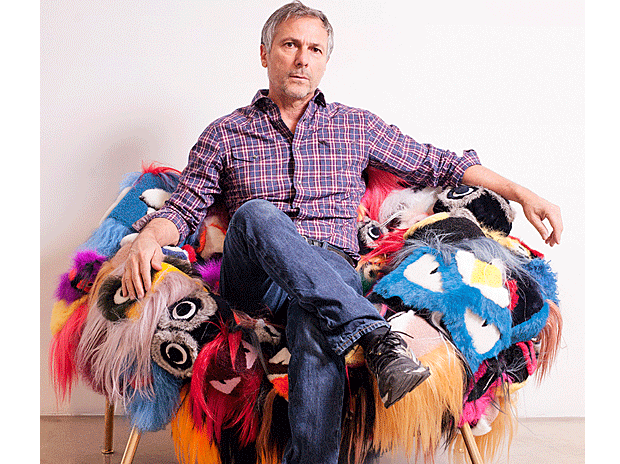Imagine Art Basel and Milan Fashion Week rolled up into a stack of eye-popping furniture, spread over 2.5 million sq ft in Italy’s fashion capital, Milan, and you get the world's largest furniture fair, the Salon del Mobile. And when you marry a venerable Roman fashion house with one of the world’s biggest designer labels, the result is bound to be unpredictable and stylish to its last seam. The ironic, striking Armchair of a Thousand Eyes is one of the fair’s most talked-about pieces this year, and not without reason: it combines decades of fur know-how by the artisans of luxury house Fendi with contemporary Brazilian creativity.
Over a hundred “bag bugs” —muppet-like bag charms that retail for about $700 a pop and have loyalists scrambling for them via pre-orders — have been assembled and hand-sewn by Fernando and Humberto Campana onto a stainless-steel banquette to create this colourful armchair. Of the Campana brothers, Silvia Venturini Fendi, third generation of Fendi family and creative director (with designer Karl Lagerfeld) says, “I’ve known and followed Fernando and Humberto for several years. We share the same passion for creativity and love for Brazil.” Tropical birds sighted in the South American nation are what originally inspired Fendi for the body less bag bugs. “It has come naturally to me to think of the Campanas for this armchair, as well as for their use of objects in such unexpected ways,” she says.
Fendi and fur have been synonymous ever since the fashion house opened its doors in 1925. Along came Karl Lagerfeld and injected the word “fun” into “fur” into Fendi — “FF” is today one of the world’s most recognisable logos. So great is the brand’s love of the modern that it has been collaborating at Design Miami with young, cutting-edge designers such as the Campana brothers since 2008.
Asked how he and his brother work together, Humberto admits he’s “more hands-on, practical, while Fernando is more creative”. In the constantly evolving world of design, communication is key. “We have a common dialogue in order to create each piece. We work in synergy,” says Humberto.
Over a hundred “bag bugs” —muppet-like bag charms that retail for about $700 a pop and have loyalists scrambling for them via pre-orders — have been assembled and hand-sewn by Fernando and Humberto Campana onto a stainless-steel banquette to create this colourful armchair. Of the Campana brothers, Silvia Venturini Fendi, third generation of Fendi family and creative director (with designer Karl Lagerfeld) says, “I’ve known and followed Fernando and Humberto for several years. We share the same passion for creativity and love for Brazil.” Tropical birds sighted in the South American nation are what originally inspired Fendi for the body less bag bugs. “It has come naturally to me to think of the Campanas for this armchair, as well as for their use of objects in such unexpected ways,” she says.
Fendi and fur have been synonymous ever since the fashion house opened its doors in 1925. Along came Karl Lagerfeld and injected the word “fun” into “fur” into Fendi — “FF” is today one of the world’s most recognisable logos. So great is the brand’s love of the modern that it has been collaborating at Design Miami with young, cutting-edge designers such as the Campana brothers since 2008.
Asked how he and his brother work together, Humberto admits he’s “more hands-on, practical, while Fernando is more creative”. In the constantly evolving world of design, communication is key. “We have a common dialogue in order to create each piece. We work in synergy,” says Humberto.
)